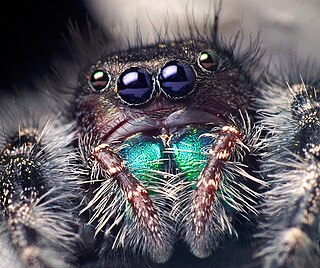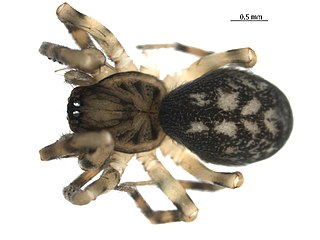
The Pholcidae are a family of araneomorph spiders. The family contains over 1,800 pholcids, including those commonly known as the marbled cellar spider , daddy long-legs spider, granddaddy long-legs spider, carpenter spider, daddy long-legger, vibrating spider, gyrating spider, long daddy, and skull spider. The family, first described by Carl Ludwig Koch in 1850, is divided into 94 genera.

Wandering spiders (Ctenidae) are a family of spiders that includes the Brazilian wandering spiders. These spiders have a distinctive longitudinal groove on the top-rear of their oval carapace similar to those of the Amaurobiidae. They are highly defensive and venomous nocturnal hunters. Despite their notoriety for being dangerous, only a few members of Phoneutria have venom known to be hazardous to humans, but the venoms of this family are poorly known, so all larger ctenids should be treated with caution.

Phidippus is a genus in the family Salticidae. Some of the largest jumping spiders inhabit this genus, and many species are characterized by their brilliant, iridescent green chelicerae. Phidippus is distributed almost exclusively in North America, with the exception of two exported species. As of January 2021, there were about 80 described species in the genus. Species previously described in Phidippus which are found in India and Bangladesh do not belong in this genus.
C. miserabilis may refer to:
Ctenus vespertilio is a species of spider from the family Ctenidae. The scientific name of this species was first published in 1941 by Cândido Firmino de Mello-Leitão, found in Colombia.

Ctenus is a genus of wandering spiders first described by Charles Athanase Walckenaer in 1805. It is widely distributed, from South America through Africa to East Asia. Little is known about the toxic potential of the genus Ctenus, however, it was recently discovered that the species Ctenus medius shares toxic properties with those presented by Phoneutria nigriventer, such as proteolytic, hyaluronidase and phospholipase activities, in addition to producing hyperalgesia and edema, the venom of C. medius also interferes with the complement system in concentrations in which the venom of P. nigriventer is inactive, indicating that this spider has a noxious venom to humans. The venom of C. medius causes an eleavage in the complement component 3 (C3) of the complement system, it affects the central factor of the cascades of the complement, and interferes with the lytic activity of this system, which causes stronger activation and consumption of the complement components. Unlike C. medius, the venom of P. nigriventer does not interfere with lytic activity.
Ctenus ceylonensis, is a species of spider of the genus Ctenus. It is endemic to Sri Lanka.
Ctenus kandyensis is a species of spiders of the genus Ctenus. It is endemic to Sri Lanka.
Ctenus thorelli, is a species of spider of the genus Ctenus. It is endemic to Sri Lanka.

Cryphoeca is a genus of araneomorph spiders in the family Cybaeidae, and was first described by Tamerlan Thorell in 1870. The name means hidden, in reference to its preference for hiding under loose bark or in stone walls.
Parabatinga is a monotypic genus of South American wandering spiders containing the single species, Parabatinga brevipes. It was first described by D. Polotow & Antônio Brescovit in a 2009 revision of Isoctenus, naming Ctenus brevipes as the female holotype and Ctenus taeniatus as the male holotype. They are found in Colombia, Brazil, Bolivia, Paraguay, Argentina, and Uruguay. The name is derived from the Tupian "paraba", meaning "spot", and "tinga", meaning white, referring to the white spots found on the ventral part of the abdomen.
Trogloctenus is a genus of wandering spiders first described by R. de Lessert in 1935. As of April 2019 it contains only two species: T. briali and T. fagei. Originally placed as a subgenus of Ctenus, it was raised to genus status in 1967.
Talanites is a genus of ground spiders that was first described by Eugène Simon in 1893.
Enoplognatha marmorata, the marbled cobweb spider, is a species of cobweb spider in the family Theridiidae. It is found in North America.

Cryphoeca exlineae is a species of true spider in the family Cybaeidae. It is found in the United States.
Ctenus captiosus, known generally as the Florida false wolf spider or tropical wolf spider, is a species of wandering spider in the family Ctenidae. It is found in the United States., and is one of two species of Ctenidae occurring in Florida. Little is known about the biology of this species.
Ctenus hibernalis is a species of wandering spider in the family Ctenidae. It is found in the United States.
Talanites exlineae is a species of ground spider in the family Gnaphosidae. It is found in the United States.







